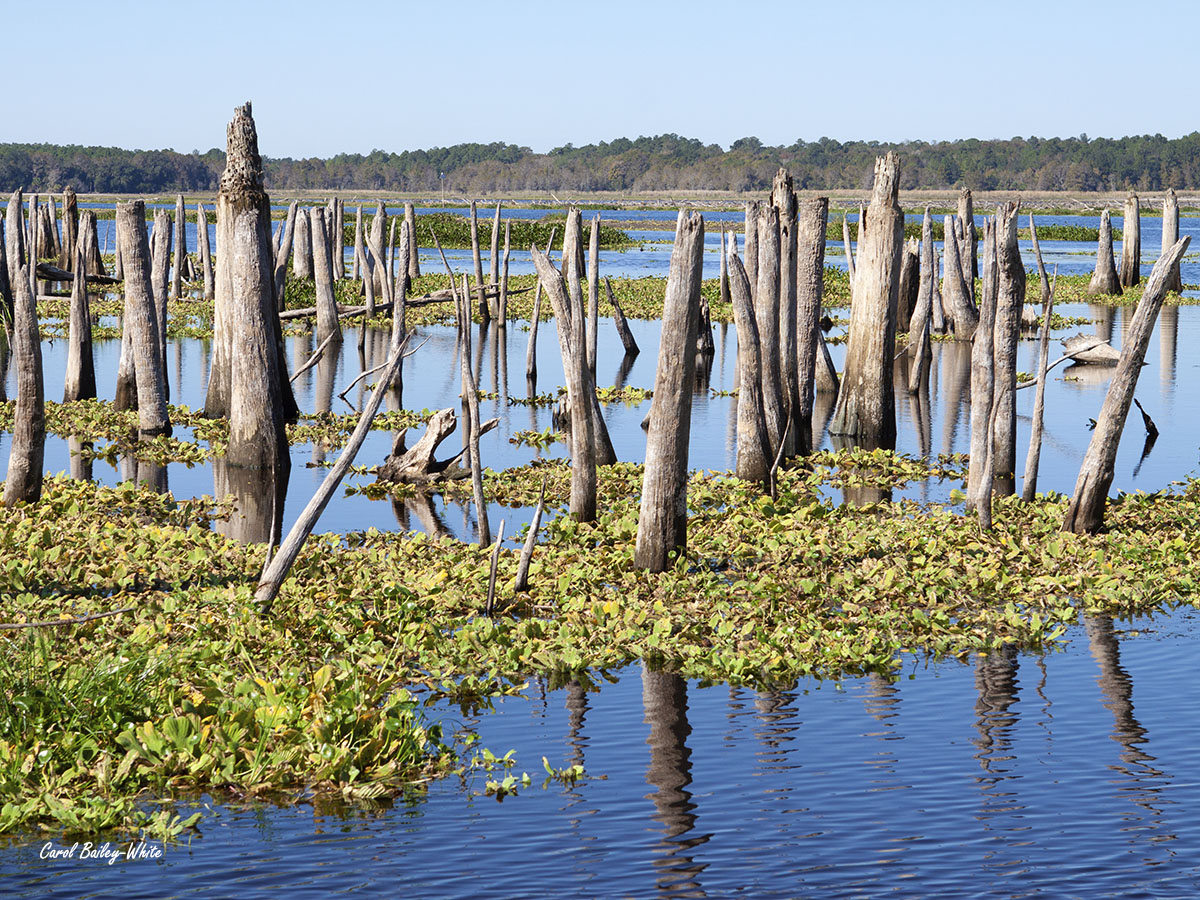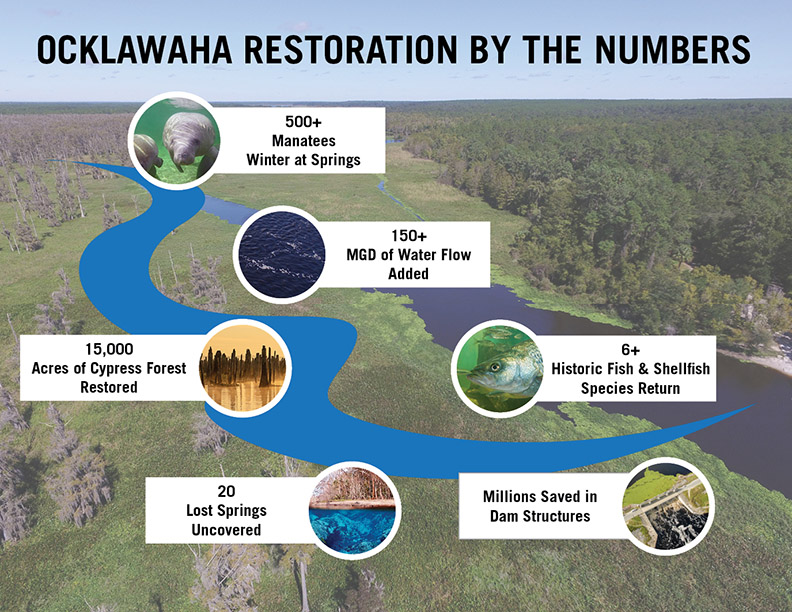Free the Ocklawaha River
 The Ocklawaha River in Putnam County is the largest tributary to the St. Johns River, but since the late 1960s the natural flow of the Ocklawaha has been blocked by the Kirkpatrick Dam (more commonly known as the Rodman Dam), a remnant of the Cross-Florida Barge Canal project, which was halted in 1971 due to the severe environmental damage that would be caused by completion of the project. Since the abandonment of the canal project, the Rodman Dam has no function other than to create a huge pool of water, drowning at least 20 natural springs and submerging 16 miles of the river and thousands of acres of forest under the massive pool. Debris and vegetation build up behind the dam, and the state of Florida regularly spends millions of dollars treating invasive aquatic vegetation in the pool. In addition, the gates of the dam must be opened every three to four years to draw the water level down to further control the excess vegetation.
The Ocklawaha River in Putnam County is the largest tributary to the St. Johns River, but since the late 1960s the natural flow of the Ocklawaha has been blocked by the Kirkpatrick Dam (more commonly known as the Rodman Dam), a remnant of the Cross-Florida Barge Canal project, which was halted in 1971 due to the severe environmental damage that would be caused by completion of the project. Since the abandonment of the canal project, the Rodman Dam has no function other than to create a huge pool of water, drowning at least 20 natural springs and submerging 16 miles of the river and thousands of acres of forest under the massive pool. Debris and vegetation build up behind the dam, and the state of Florida regularly spends millions of dollars treating invasive aquatic vegetation in the pool. In addition, the gates of the dam must be opened every three to four years to draw the water level down to further control the excess vegetation.
We are now at a critical juncture: the dam is reaching the age where the structure either needs to be completely renovated, or breached to drain the pool for good and allow the natural flow of the Ocklawaha to be restored. The St. Johns River Water Management District is conducting a survey of Florida residents, available through October 22, 2021, about the fate of the dam. Almost certainly, the majority opinion from this survey will determine the outcome (simply put, to breach the dam or repair it), so your input is critically important. We encourage you to learn about the history of the dam and the long-running controversy surrounding it, and then complete the survey at https://floridaswater.formstack.com/forms/rodman.
 Our chapter, along with Audubon Florida, St. Johns RIVERKEEPER, Sierra Club Florida, Florida Native Plant Society and many other environmental organizations, supports breaching the dam and returning the Ocklawaha River to its natural channel. Over time, this would restore many thousands of acres of currently submerged or stressed floodplain forest. It would release the many freshwater springs that are currently suppressed under the weight of the Rodman pool (sometimes referred to as Lake Ocklawaha). It would create a discharge of at least 150 million gallons of fresh water a day into the St. Johns River, improving water quality in the St. Johns and helping the river resist saltwater intrusion from sea level rise. Birds and wildlife native to the area would return, as this part of the Florida Wildlife Corridor would be restored. Manatees would again be able to swim unimpeded all the way to Silver Springs from the St. Johns River. Fish that go from the ocean to inland rivers to spawn could do so unimpeded.
Our chapter, along with Audubon Florida, St. Johns RIVERKEEPER, Sierra Club Florida, Florida Native Plant Society and many other environmental organizations, supports breaching the dam and returning the Ocklawaha River to its natural channel. Over time, this would restore many thousands of acres of currently submerged or stressed floodplain forest. It would release the many freshwater springs that are currently suppressed under the weight of the Rodman pool (sometimes referred to as Lake Ocklawaha). It would create a discharge of at least 150 million gallons of fresh water a day into the St. Johns River, improving water quality in the St. Johns and helping the river resist saltwater intrusion from sea level rise. Birds and wildlife native to the area would return, as this part of the Florida Wildlife Corridor would be restored. Manatees would again be able to swim unimpeded all the way to Silver Springs from the St. Johns River. Fish that go from the ocean to inland rivers to spawn could do so unimpeded.
Repairs to the current dam are estimated at $14 million, plus $400,000 in annual maintenance costs, all funded by Florida taxpayer dollars. If the dam is breached, the cost of drawdowns and chemical treatment of invasive aquatic vegetation control would be largely unnecessary. While the pool has long been a popular fishing spot, it is projected that a free-flowing Ocklawaha River would provide even more recreational opportunities than the current pool. You can learn more about the projected benefits from breaching the dam at FreeTheOcklawaha.com.
Please find the time to fill out the St. Johns River Water Management District survey. Sample questions and suggested responses to help you prepare are available here. The more Florida residents who express their preference for breaching this long-disputed dam, the more likely it will finally happen. Thank you!
~ Carolyn Antman, Conservation Director for Duval County, and Carol Bailey-White, Chapter President
